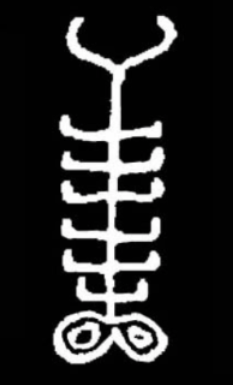Plasma Scientist Anthony Peratt Meets the Electric Universe
By David Talbott
PART 3: Stickman on Stone
Evidence gathered from around the world has made abundantly clear that intense electrical activity above observers on earth was the subject of massive collective endeavors to record the forms on stone. Especially compelling is the rock art theme called the “stickman.”
In the illustrations above, a well-documented electric discharge form in the laboratory (two graphics on the upper left) is compared to the remarkably similar rock art carvings from different parts of the world.
The rock art stickmen above are taken from Anthony Peratt’s 2003 paper in “Transactions on Plasma Science” of the Institute of Electrical and Electronics Engineers. Peratt states his conclusion forthrightly: “[The recurring petroglyph patterns] are reproductions of plasma phenomena in space.”
Of course, the majority of rock art authorities, particularly those with primary interest in Native American sources, argue that only images of the sun, moon, and stars reflect actual celestial phenomena. Apart from such associations, most authorities claim that global patterns do not exist. Rather, they tell us, the ancient artists projected onto stone the subjective content of shamanistic trances. Peratt’s investigations say the opposite—that the most fundamental patterns of rock art occur globally. Through massive labors, some apparently taking whole lifetimes according to Peratt, the artists carved into stone observed electric discharge phenomena in the heavens.

Hawaii Stickman
The “stickman” configuration occurs when a disk or donut-like torus around a linear discharge column is bent by magnetic fields induced by intense current flow. From the viewpoint of the observer, the edges of the upper disk may appear to point up (forming “arms”) and those of the lower torus may appear to point down (forming “legs”.) The underlying “hourglass” pattern, with many subtle variations, not only occurs around the world, it is among the most fundamental forms appearing in highest-energy electric discharge in the laboratory.
To appreciate the evolution of the discharge configuration, the two upper-left graphics of the opening illustration must be visualized three- dimensionally. These illustrations show the structure of a translucent plasma discharge, whose 3-D configuration would would not be self evident in a rendition carved on rock. A key consideration: rotating the configuration on its axis would not change the basic form or appearance to the observer.
Our idealization of the dynamic geometry shows slight variations between the upward-pointing and downward-pointing components, consistent with common variations in the laboratory and in rock art. The upper “champagne glass” form results from a distortion of a disk as the edges curve upward. In the warping of the disk below, the downward curvature is interrupted at the extremity, which bends outward to create a “squashed bell” appearance.
The rock art images in this series are all characteristic of intense plasma discharge. In the case at hand, the idealization of the hourglass discharge form accents the visual relationship of the two symmetrical dots or circles to a transparent doughnut-like torus, viewed edge on. But many other nuances of such discharge configurations must be taken into account, since the warping of the upward and downward extremities of the hourglass form can occur in almost limitless variations.

Kayenta Pictograph
If Peratt’s conclusions are correct, then several thousand years ago the terrestrial sky was ablaze with electrical activity. The ramifications of this possibility will directly affect understanding of cultural roots the world over. What was the impact of the recorded events on the early civilizations? What was the relationship to the origins of world mythology, to the birth of the early religions, or to the massive ancient investments in monumental construction?
Both the rock artists and the myth-makers had true perils on their minds. The rock artists recorded and the myth-makers interpreted electrical events in the sky, as plasma discharge sequences moved through discrete phases, some of celestial beauty, others intensely violent and terrifying.
The most essential issues concern the connectedness between seemingly different rock-art themes. For example, was there a relationship between the Kayenta pictograph previously noted and the global stickman image and why is the Kayenta form more sparsely recorded than the worldwide stickman image? There is good reason for this, according to Peratt. The Kayenta pictograph signifies a critical moment just prior to a collapse of that more complex form into the simpler stickman form. The synchrotron radiation preceding that transition would have been deadly, making it close to impossible for humans to record the form while standing in the open.


